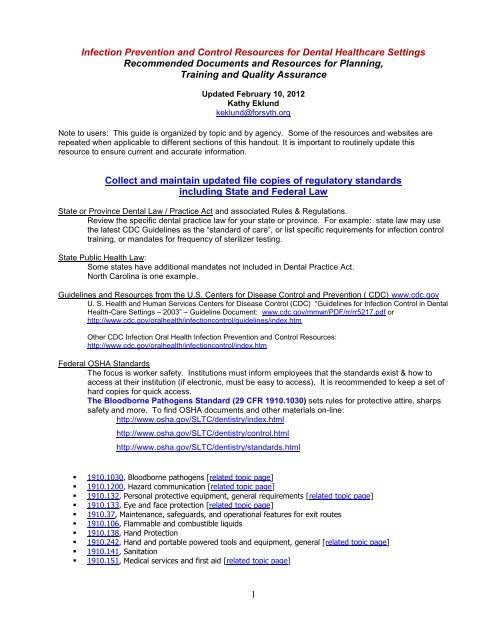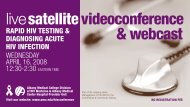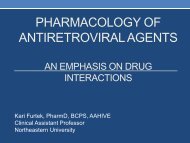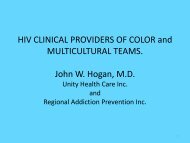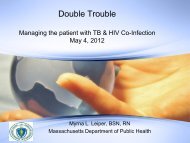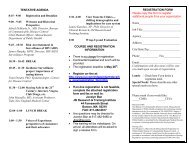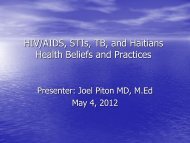Infection Prevention and Control Resources for Dental Healthcare
Infection Prevention and Control Resources for Dental Healthcare
Infection Prevention and Control Resources for Dental Healthcare
Create successful ePaper yourself
Turn your PDF publications into a flip-book with our unique Google optimized e-Paper software.
<strong>Infection</strong> <strong>Prevention</strong> <strong>and</strong> <strong>Control</strong> <strong>Resources</strong> <strong>for</strong> <strong>Dental</strong> <strong>Healthcare</strong> Settings<br />
Recommended Documents <strong>and</strong> <strong>Resources</strong> <strong>for</strong> Planning,<br />
Training <strong>and</strong> Quality Assurance<br />
Updated February 10, 2012<br />
Kathy Eklund<br />
keklund@<strong>for</strong>syth.org<br />
Note to users: This guide is organized by topic <strong>and</strong> by agency. Some of the resources <strong>and</strong> websites are<br />
repeated when applicable to different sections of this h<strong>and</strong>out. It is important to routinely update this<br />
resource to ensure current <strong>and</strong> accurate in<strong>for</strong>mation.<br />
Collect <strong>and</strong> maintain updated file copies of regulatory st<strong>and</strong>ards<br />
including State <strong>and</strong> Federal Law<br />
State or Province <strong>Dental</strong> Law / Practice Act <strong>and</strong> associated Rules & Regulations.<br />
Review the specific dental practice law <strong>for</strong> your state or province. For example: state law may use<br />
the latest CDC Guidelines as the “st<strong>and</strong>ard of care”, or list specific requirements <strong>for</strong> infection control<br />
training, or m<strong>and</strong>ates <strong>for</strong> frequency of sterilizer testing.<br />
State Public Health Law:<br />
Some states have additional m<strong>and</strong>ates not included in <strong>Dental</strong> Practice Act.<br />
North Carolina is one example.<br />
Guidelines <strong>and</strong> <strong>Resources</strong> from the U.S. Centers <strong>for</strong> Disease <strong>Control</strong> <strong>and</strong> <strong>Prevention</strong> ( CDC) www.cdc.gov<br />
U. S. Health <strong>and</strong> Human Services Centers <strong>for</strong> Disease <strong>Control</strong> (CDC) “Guidelines <strong>for</strong> <strong>Infection</strong> <strong>Control</strong> in <strong>Dental</strong><br />
Health-Care Settings – 2003” – Guideline Document: www.cdc.gov/mmwr/PDF/rr/rr5217.pdf or<br />
http://www.cdc.gov/oralhealth/infectioncontrol/guidelines/index.htm<br />
Other CDC <strong>Infection</strong> Oral Health <strong>Infection</strong> <strong>Prevention</strong> <strong>and</strong> <strong>Control</strong> <strong>Resources</strong>:<br />
http://www.cdc.gov/oralhealth/infectioncontrol/index.htm<br />
Federal OSHA St<strong>and</strong>ards<br />
The focus is worker safety. Institutions must in<strong>for</strong>m employees that the st<strong>and</strong>ards exist & how to<br />
access at their institution (if electronic, must be easy to access). It is recommended to keep a set of<br />
hard copies <strong>for</strong> quick access.<br />
The Bloodborne Pathogens St<strong>and</strong>ard (29 CFR 1910.1030) sets rules <strong>for</strong> protective attire, sharps<br />
safety <strong>and</strong> more. To find OSHA documents <strong>and</strong> other materials on-line:<br />
http://www.osha.gov/SLTC/dentistry/index.html<br />
http://www.osha.gov/SLTC/dentistry/control.html<br />
http://www.osha.gov/SLTC/dentistry/st<strong>and</strong>ards.html<br />
• 1910.1030, Bloodborne pathogens [related topic page]<br />
• 1910.1200, Hazard communication [related topic page]<br />
• 1910.132, Personal protective equipment, general requirements [related topic page]<br />
• 1910.133, Eye <strong>and</strong> face protection [related topic page]<br />
• 1910.37, Maintenance, safeguards, <strong>and</strong> operational features <strong>for</strong> exit routes<br />
• 1910.106, Flammable <strong>and</strong> combustible liquids<br />
• 1910.138, H<strong>and</strong> Protection<br />
• 1910.242, H<strong>and</strong> <strong>and</strong> portable powered tools <strong>and</strong> equipment, general [related topic page]<br />
• 1910.141, Sanitation<br />
• 1910.151, Medical services <strong>and</strong> first aid [related topic page]<br />
1
The St<strong>and</strong>ard: This is the link to the full Bloodborne Pathogens St<strong>and</strong>ard<br />
http://www.osha.gov/pls/oshaweb/owadisp.show_documentp_table=STANDARDS&p_id=10051<br />
Recordkeeping - including a model sharps injury log: Go to<br />
http://www.osha.gov/Publications/OSHA3187/osha3187.html<br />
http://osha.gov/recordkeeping/index.html<br />
A model exposure control plan organizes the required in<strong>for</strong>mation in a fill-in-the-blank template:<br />
http://www.osha.gov/OshDoc/Directive_pdf/CPL_2-2_69_APPD.pdf<br />
The full en<strong>for</strong>cement directive document may be seen at:<br />
http://www.osha.gov/pls/oshaweb/owadisp.show_documentp_table=DIRECTIVES&p_id=2570<br />
The Hazard Communications St<strong>and</strong>ard (29 CFR 1910.1200) requires training <strong>for</strong> chemicals <strong>and</strong><br />
other hazards in the dental workplace. The General Duty Clause cites requirements <strong>for</strong> exits,<br />
emergency evacuations, etc. Full text of the St<strong>and</strong>ard available at:<br />
http://www.osha.gov/SLTC/dentistry/st<strong>and</strong>ards.html<br />
Other OSHA online resources <strong>for</strong> dental hazards include:<br />
Nitrous Oxide / anesthetic gases:<br />
http://www.osha.gov/dts/osta/anestheticgases/index.html<br />
http://www.cdc.gov/niosh/nitoxide.html<br />
http://www.cdc.gov/niosh/noxidalr.html<br />
State OSHA Plans: The following states have approved OSHA State Plans:<br />
Alaska, Arizona, Cali<strong>for</strong>nia, Connecticut, Hawaii, Indiana, Iowa, Kentucky, Maryl<strong>and</strong>, Michigan,<br />
Minnesota, Nevada, New Jersey, New Mexico, New York, North Carolina, Oregon, Puerto Rico,<br />
South Carolina, Tennessee, Utah, Vermont, Virgin Isl<strong>and</strong>s, Virginia, Washington, Wyoming.<br />
Connecticut, New Jersey, New York <strong>and</strong> Virgin Isl<strong>and</strong>s plans cover public sector (state <strong>and</strong> local<br />
government workers) only.<br />
http://www.osha.gov/dcsp/osp/index.html<br />
EPA Regulations.<br />
Hazardous waste management, waste water treatment, etc.<br />
Federal regulations prevail unless your region or state has unique EPA regulations.<br />
Your institution or campus safety manager may be a resource <strong>for</strong> local / state regulations.<br />
Special dental issues include disposal of biohazard waste <strong>and</strong> chemical waste such as mercury /<br />
amalgam <strong>and</strong> radiographic processing wastes. For example, some states require amalgam<br />
separators. Waste disposal <strong>and</strong> EPA regulations may be cited in state <strong>Dental</strong> Practice Law.<br />
www.epa.gov<br />
Collect print copies of “Must Have” Guidelines <strong>and</strong> Forms<br />
U. S. Health <strong>and</strong> Human Services Centers <strong>for</strong> Disease <strong>Control</strong> (CDC)<br />
“Guidelines <strong>for</strong> <strong>Infection</strong> <strong>Control</strong> in <strong>Dental</strong> Health-Care Settings – 2003” –<br />
www.cdc.gov/mmwr/PDF/rr/rr5217.pdf<br />
This document is frequently cited as the “st<strong>and</strong>ard of care”. Provides evidence based guidance <strong>for</strong><br />
many aspects of infection control management. Includes continuing education, references. Use in<br />
conjunction with OSHA St<strong>and</strong>ards to produce a complete <strong>Infection</strong> <strong>Control</strong> <strong>and</strong> Safety Compliance<br />
Policy. Tip: Obtain print copies <strong>for</strong> key institution / clinic personnel (clinic managers, clinic<br />
coordinators, Associate Clinical Deans).<br />
Free individual print copies may also be obtained by calling: 770.488.6054.<br />
U. S. Department of Labor Occupational Safety <strong>and</strong> Health Administration (OSHA)<br />
2
OSHA St<strong>and</strong>ards: “General Duty Clause”, Bloodborne Pathogens, <strong>and</strong> Hazard Communications.<br />
At least one print copy of each st<strong>and</strong>ard should be kept on file.<br />
http://www.osha.gov/SLTC/dentistry/st<strong>and</strong>ards.html<br />
OSHA Compliance Assistance on-line program: “Quickstarts”<br />
This is not a separate set of regulations but OSHA’s version of a “Guide to the St<strong>and</strong>ards”.<br />
This step by step guide has a specific section on <strong>Healthcare</strong> <strong>and</strong> links the user to most of the OSHA<br />
compliance <strong>for</strong>ms.<br />
http://www.osha.gov/dcsp/compliance_assistance/quickstarts/index.html<br />
OSAP – Organization <strong>for</strong> Safety, Asepsis <strong>and</strong> <strong>Prevention</strong><br />
From Policy to Practice: OSAP’s Guide to the Guidelines.<br />
This 170 page workbook contains practical in<strong>for</strong>mation to assist health care professionals in<br />
implementing the CDC Guidelines. The workbook was produced by OSAP through a CDC<br />
cooperative agreement. The workbook may be ordered from the OSAP on-line “store” at<br />
www.osap.org<br />
<strong>Infection</strong> <strong>Control</strong> <strong>and</strong> Safety Guidelines Checklist<br />
OSAP, in its January 2004 issue of <strong>Infection</strong> <strong>Control</strong> in Practice, turned the CDC Guidelines For<br />
<strong>Infection</strong> <strong>Control</strong> in <strong>Dental</strong> Health-Care Settings - 2003 into a checklist.. This checklist is a valuable<br />
resource to help practices follow these important CDC infection control guidelines.<br />
Click HERE to download the checklist.<br />
http://www.osap.org/displaycommon.cfman=1&subarticlenbr=370<br />
Use Low Cost or Free Media <strong>and</strong> Training Programs<br />
Slide Presentation on <strong>Infection</strong> <strong>Control</strong> <strong>for</strong> <strong>Dental</strong> Offices, produced by the CDC.<br />
Slide presentation on infection control <strong>for</strong> dental offices<br />
www.cdc.gov/oralhealth/infectioncontrol/guidelines/ppt.htm<br />
Free slide presentation in powerpoint <strong>for</strong>mat produced by the Centers <strong>for</strong> Disease <strong>Control</strong>. This<br />
program provides an overview of basic principles contained in the CDC Guidelines <strong>for</strong> <strong>Infection</strong><br />
<strong>Control</strong> in <strong>Dental</strong> Health-Care Settings—2003. It can be downloaded as a PowerPoint presentation<br />
or viewed on the Web site. Good visuals <strong>and</strong> charts.<br />
From Policy to Practice: OSAP’s Interactive Guide to the CDC Guidelines.<br />
The Organization <strong>for</strong> Safety, Asepsis <strong>and</strong> <strong>Prevention</strong> (OSAP) has an on-line interactive educational tool<br />
designed to provide education <strong>and</strong> training in basic infection control principles <strong>and</strong> the CDC Guidelines <strong>for</strong><br />
<strong>Infection</strong> <strong>Control</strong> in <strong>Dental</strong> Health-Care Settings. This is an excellent tool <strong>for</strong> entry level training <strong>and</strong> as<br />
refresher training. There is no charge to access <strong>and</strong> view the complete course. For those who wish to be<br />
tested on the material <strong>and</strong> earn 10 CE credits, processing fees apply. Free, self paced, modular, interactive<br />
http://osaplms.ts.karta.com/<br />
The OSAP/Interact Training System<br />
The OSAP Interact Training System is a comprehensive infection control <strong>and</strong> safety education <strong>and</strong> training<br />
program. The system can be used in educational settings as well as institutional <strong>and</strong> private practice dental<br />
settings. The system consists of individual interactive workbooks <strong>for</strong> personnel <strong>and</strong> DVD presentations that<br />
coordinate with the workbooks. The system is designed to integrate CDC guidelines, OSHA regulations <strong>and</strong><br />
basic infection control principles with site-specific infection control <strong>and</strong> safety policies <strong>and</strong> procedures.<br />
Updated March 2008. http://www.osap.org/displaycommon.cfman=1&subarticlenbr=39<br />
3
If Saliva Were Red: A Visual Lesson on <strong>Infection</strong> <strong>Control</strong><br />
This classic is an 8 minute video training system. Features two segments – one illustrating dental<br />
procedures without most of the recommended barriers <strong>and</strong> practices; then another segment with<br />
recommendations in use. Red dyes are incorporated to illustrate the otherwise invisible cross<br />
contamination potential of saliva <strong>and</strong> other oral fluids. The program is not narrated, allowing great<br />
flexibility in use. The program includes a trainer’s guide <strong>and</strong> is available to order from OSAP at the<br />
on-line “store”.<br />
If Saliva Were Red<br />
www.osap.org<br />
CDC H<strong>and</strong> Hygiene Course.<br />
Free, online interactive course in Powerpoint <strong>for</strong>mat with short video action clip demonstrating h<strong>and</strong><br />
hygiene techniques using soap <strong>and</strong> water <strong>and</strong> alcohol h<strong>and</strong> rub. Access course at:<br />
www.cdc.gov/h<strong>and</strong>hygiene/training/interactiveEducation/<br />
OSHA’s Needlestick <strong>Prevention</strong> powerpoint slide program:<br />
“Safer Needle Devices: Protecting Health Care Workers” Includes illustrations of safety needle<br />
devices. Available free at<br />
www.osha.gov/dcsp/ote/library/bloodborne/revised_bbp_st<strong>and</strong>ard.ppt<br />
OSHA media presentations.<br />
Topics include an overview of bloodborne pathogens st<strong>and</strong>ard, ergonomics, introduction to ionizing<br />
radiation, etc. Most are available as powerpoint slide programs.<br />
www.osha.gov/SLTC/multimedia.html<br />
Post Exposure Protocols <strong>and</strong> Sharps Safety<br />
CDC <strong>and</strong> U.S. Public Health Service Guidelines <strong>for</strong> Management of Occupational Exposures<br />
<strong>and</strong> Post exposure prophylaxis:<br />
http://www.cdc.gov/ncidod/dhqp/gl_occupational.html<br />
http://www.cdc.gov/mmwr/PDF/rr/rr5409.pdf<br />
Centers <strong>for</strong> Disease <strong>Control</strong> <strong>and</strong> <strong>Prevention</strong> (CDC), Morbidity <strong>and</strong> Mortality Weekly Report<br />
(MMWR) 50(RR11);1-42 (2001, This provides the current CDC recommendations <strong>for</strong> post exposure<br />
management that should be used by the designated health care provider.<br />
http://www.cdc.gov/mmwr/preview/mmwrhtml/rr5011a1.htm<br />
CDC Sharps Injury <strong>Prevention</strong> <strong>and</strong> Safety Device Evaluation <strong>Resources</strong><br />
Centers <strong>for</strong> Disease <strong>Control</strong> <strong>and</strong> <strong>Prevention</strong> (CDC) has developed two sample <strong>for</strong>ms (with instructions <strong>for</strong><br />
use) to assist dental personnel in screening <strong>and</strong> evaluating devices <strong>for</strong> clinical acceptability. These <strong>for</strong>ms<br />
have been pilot tested with focus groups of different types of dental staff members, including end users <strong>and</strong><br />
purchasers. To increase the safety of both dental personnel <strong>and</strong> their patients, we are making these <strong>for</strong>ms<br />
available <strong>for</strong> general use. Although these <strong>for</strong>ms are specific <strong>for</strong> anesthetic syringes, they can be modified <strong>for</strong><br />
use with other types of dental devices. http://www.cdc.gov/oralhealth/infectioncontrol/<strong>for</strong>ms.htm<br />
OSHA web sites specific <strong>for</strong> exposure prevention <strong>and</strong> post exposure requirements:<br />
http://www.osha.gov/SLTC/bloodbornepathogens/index.html<br />
http://www.osha.gov/SLTC/bloodbornepathogens/postexposure.html<br />
OSHA Recordkeeping Requirements: OSHA has specific injury recordkeeping requirements<br />
http://osha.gov/recordkeeping/index.html<br />
American <strong>Dental</strong> Association (ADA) resources <strong>for</strong> post exposure management<br />
Documents provides guidance to dental employers about their responsibilities under the OSHA<br />
st<strong>and</strong>ard <strong>for</strong> providing post-exposure evaluation <strong>and</strong> follow-up <strong>for</strong> employees exposed to bloodborne<br />
pathogens.<br />
http://www.ada.org/prof/resources/topics/osha/intro.asp<br />
4
PEPline: National Clinicians Post Exposure Prophylaxis Hotline 1.888.448.4911<br />
Available 24/7. Experts can provide timely advice <strong>and</strong> reassurance regarding actual levels of risk<br />
based on exposure factors. Does not take the place of an established procedure <strong>for</strong> referral of<br />
exposed, injuried persons.<br />
http://www.ucsf.edu/hivcntr/Hotlines/PEPline.html<br />
Injection Safety Topics: References oriented toward medical / hospital providers.<br />
Helpful <strong>for</strong> educational institutions with oral surgery or hospital based components.<br />
http://www.cdc.gov/ncidod/dhqp/injectionsafety.html<br />
Needle Safety Act <strong>and</strong> Evaluation of Safer Devices.<br />
Includes background in<strong>for</strong>mation, sample evaluation <strong>for</strong>ms <strong>and</strong> recommendations.<br />
http://www.cdc.gov/oralhealth/infectioncontrol/<strong>for</strong>ms.htm<br />
Commercial examples of safety devices:<br />
Sultan Chemists. This is an eight minute flash tutorial on a safer needle device to help prevent<br />
needlestick injuries <strong>for</strong> dentists. Caution: Use of video alone does not meet the intent of the Needle<br />
Safety Act. Clinicians <strong>and</strong> staff should conduct h<strong>and</strong>s – on evaluations of needle safety devices.<br />
The One Shot Syringe Tutorial.<br />
<strong>Resources</strong> <strong>for</strong> Immunization Recommendations<br />
CDC Immunization <strong>Resources</strong> <strong>for</strong> <strong>Healthcare</strong> Personnel<br />
http://www.cdc.gov/vaccines/hcp.htm#healthcare <strong>and</strong> http://www.cdc.gov/vaccines/<br />
This site on the CDC website provides valuable in<strong>for</strong>mation <strong>and</strong> educational <strong>and</strong> training resources <strong>for</strong><br />
healthcare personnel <strong>and</strong> immunizations <strong>for</strong> vaccine preventable diseases.<br />
<strong>Resources</strong>(publications, Vaccine In<strong>for</strong>mation Statements, etc.)<br />
Immunizations <strong>for</strong> <strong>Healthcare</strong> Personnel<br />
Immunization Schedules<br />
Guidelines / Recommendations <strong>and</strong> Vaccine Administration<br />
Vaccines <strong>and</strong> VPDs<br />
Vaccine Shortages <strong>and</strong> Delays<br />
Vaccine Storage <strong>and</strong> H<strong>and</strong>ling<br />
CDC Immunization Recommendations <strong>for</strong> <strong>Healthcare</strong> Personnel:<br />
Visit this website <strong>for</strong> general in<strong>for</strong>mation about immunizations <strong>for</strong> healthcare workers:<br />
http://www.cdc.gov/vaccines/spec-grps/hcw.htm<br />
Centers <strong>for</strong> Disease <strong>Control</strong> (CDC) “Guidelines <strong>for</strong> <strong>Infection</strong> <strong>Control</strong> in <strong>Dental</strong> Health-Care Settings –<br />
2003” Review pages 8, 9, Recommendation #1. A. 1. <strong>and</strong> Appendix B<br />
www.cdc.gov/mmwr/PDF/rr/rr5217.pdf<br />
Resource Summary Table of Immunization Recommendations <strong>for</strong> HCP<br />
A summary of immunization guidelines is also available at:<br />
http://www.immunize.org/catg.d/p2017.pdf<br />
CDC Influenza http://www.cdc.gov/flu/<br />
Influenza In<strong>for</strong>mation <strong>for</strong> <strong>Healthcare</strong> Professionals<br />
http://www.cdc.gov/flu/professionals/index.htm<br />
5
<strong>Infection</strong> <strong>Control</strong> Guidance <strong>for</strong> <strong>Healthcare</strong> Settings<br />
http://www.cdc.gov/flu/professionals/infectioncontrol/<br />
http://www.cdc.gov/oralhealth/infectioncontrol/factsheets/2009_h1n1.htm<br />
CDC Guideline: <strong>Prevention</strong> Strategies <strong>for</strong> Seasonal Influenza in <strong>Healthcare</strong><br />
Settings<br />
http://www.cdc.gov/flu/professionals/infectioncontrol/healthcaresettings.ht<br />
m<br />
Hazard / Chemical <strong>Control</strong> Program <strong>Resources</strong><br />
The Hazard Communications St<strong>and</strong>ard (29 CFR 1910.1200) requires training <strong>for</strong> chemicals <strong>and</strong> other<br />
hazards in the dental workplace. The General Duty Clause cites requirements <strong>for</strong> exits, emergency<br />
evacuations, etc. Full text of the St<strong>and</strong>ard available at:<br />
http://www.osha.gov/SLTC/dentistry/st<strong>and</strong>ards.html<br />
Identify <strong>and</strong> inventory the chemical <strong>and</strong> physical hazards (compressed gases, dental materials <strong>and</strong> devices,<br />
radiation, mercury, etc. found in your facility.<br />
http://www.osha.gov/SLTC/dentistry/recognition.html<br />
Nitrous Oxide <strong>and</strong> other gases:<br />
http://www.osha.gov/dts/osta/anestheticgases/index.html<br />
National Institute <strong>for</strong> Occupational Safety <strong>and</strong> Health (NIOSH), DHHS Publication No. 96-107,<br />
Hazard <strong>Control</strong> HC3 (1996), 6 pages. This document presents NIOSH research that shows controls<br />
including system maintenance, ventilation, <strong>and</strong> operations. Includes step-by-step approach to<br />
controlling N 2 O exposure.<br />
http://www.cdc.gov/niosh/nitoxide.html<br />
National Institute <strong>for</strong> Occupational Safety <strong>and</strong> Health (NIOSH), DHHS Publication No. 94-100<br />
(1996, August 5), 8 pages. This alert presents control measures <strong>for</strong> preventing or greatly reducing<br />
exposure to N 2 O during the administration of anesthetic gas.<br />
http://www.cdc.gov/niosh/noxidalr.html<br />
NIOSH – National Institute <strong>for</strong> Occupational Safety <strong>and</strong> Health<br />
(Nitrous Oxide, Lab materials, Latex, etc.)<br />
www.cdc.gov/OralHealth/infectioncontrol/<br />
Beryllium Hazards in <strong>Dental</strong> Laboratories<br />
OSHA (2002, May), 42 KB PDF, 9 pages. Hazard In<strong>for</strong>mation Bulletin (HIB) in<strong>for</strong>ms employers <strong>and</strong><br />
employees about risk of dental laboratory technicians developing chronic beryllium disease (CBD).<br />
http://www.osha.gov/dts/hib/hib_data/hib20020419.pdf<br />
More Centers <strong>for</strong> Disease <strong>Control</strong> <strong>Infection</strong> <strong>Control</strong> Guidelines/ Documents:<br />
CDC's Oral Health <strong>Resources</strong> site <strong>for</strong> infection control in dentistry:<br />
http://www.cdc.gov/oralhealth/infectioncontrol/index.htm<br />
Frequently Asked Questions in <strong>Infection</strong> <strong>Control</strong>.<br />
Guidelines <strong>for</strong> Protecting Patients <strong>and</strong> Health Care Workers (by date)<br />
http://www.cdc.gov/ncidod/dhqp/guidelines.html<br />
6
Guidelines <strong>for</strong> Protecting Patients (by date)<br />
CDC Guideline: <strong>Prevention</strong> Strategies <strong>for</strong> Seasonal Influenza in <strong>Healthcare</strong> Settings<br />
http://www.cdc.gov/flu/professionals/infectioncontrol/healthcaresettings.htm<br />
Guideline <strong>for</strong> Disinfection <strong>and</strong> Sterilization in <strong>Healthcare</strong> Facilities, 2008<br />
PDF (1.80 MB / 158 pages<br />
Guideline <strong>for</strong> Isolation Precautions 2007<br />
Management of Multidrug-Resistant Organism 2006 PDF (233 KB, 74 page)<br />
Preventing <strong>Healthcare</strong>-Associated Pneumonia, 2003<br />
Environmental <strong>Infection</strong> <strong>Control</strong> in <strong>Healthcare</strong> Facilities, 2003<br />
H<strong>and</strong> Hygiene in <strong>Healthcare</strong> Settings, 2002<br />
<strong>Prevention</strong> of Intravascular Device-Related <strong>Infection</strong>s, 2002<br />
<strong>Prevention</strong> of Surgical Site <strong>Infection</strong>s, 1999<br />
<strong>Prevention</strong> of Catheter Associated Urinary Tract <strong>Infection</strong>s, 1981<br />
CDC Guidelines <strong>for</strong> Protecting <strong>Healthcare</strong> Workers (by date)<br />
Management of Occupational Exposures to Hepatitis B, Hepatitis C, <strong>and</strong> HIV <strong>and</strong> Recommendations <strong>for</strong><br />
Postexposure Prophylaxis - 2001<br />
<strong>Infection</strong> <strong>Control</strong> in <strong>Healthcare</strong> Personnel - 1998<br />
See more <strong>Healthcare</strong> Worker Occupational Health Guidelines<br />
http://www.cdc.gov/ncidod/dhqp/wrkr_occHealth.html<br />
CDC Seasonal Influenza <strong>and</strong> 2009 H1N1 Influenza: <strong>Resources</strong> <strong>for</strong> Clinicians<br />
http://www.cdc.gov/flu/about/season/index.htm<br />
http://www.cdc.gov/flu/professionals/index.htm<br />
http://www.cdc.gov/h1n1flu/clinicians/<br />
http://www.cdc.gov/flu/professionals/infectioncontrol/<br />
CDC H1N1 Influenza A : http://www.cdc.gov/h1n1flu/<br />
<strong>Infection</strong> <strong>Control</strong> In a <strong>Healthcare</strong> Setting<br />
o http://www.cdc.gov/flu/professionals/infectioncontrol/index.htm<br />
o Q&A: Updating Guidance on <strong>Infection</strong> <strong>Control</strong> Measures <strong>for</strong> Influenza in <strong>Healthcare</strong> Settings<br />
o Q&A: Respiratory Protection For Preventing 2009 H1N1 Influenza Among <strong>Healthcare</strong><br />
Personnel<br />
Tuberculosis (TB)<br />
CDC Guidelines <strong>for</strong> Preventing the Transmission of Mycobacterium tuberculosis in Health-Care Settings,<br />
2005. http://www.cdc.gov/mmwr/preview/mmwrhtml/rr5417a1.htm (last cited October 2, 2010)<br />
Publication <strong>for</strong> Dentistry:<br />
Tuberculosis <strong>Infection</strong> <strong>Control</strong> <strong>for</strong> Dentistry (September 2009)<br />
Clevel<strong>and</strong> JL, Robison VA, Panlilio AL. Tuberculosis epidemiology, diagnosis <strong>and</strong> infection control<br />
recommendations <strong>for</strong> dental settings: An update on the Centers <strong>for</strong> Disease <strong>Control</strong> <strong>and</strong> <strong>Prevention</strong><br />
guidelines. J Am Dent Assoc 2009;140:1092–1099.<br />
7
General Facemasks <strong>and</strong> Respiratory Protection In<strong>for</strong>mation<br />
Facemask <strong>and</strong> Respirator Use <strong>for</strong> Home Community <strong>and</strong> Occupational Settings<br />
CDC :<br />
www.cdc.gov/Features/MasksRespirators/<br />
www.cdc.gov/niosh/npptl/topics/respirators/disp_part/RespSource3.html#e<br />
FDA:<br />
www.fda.gov/MedicalDevices/Products<strong>and</strong>MedicalProcedures/GeneralHospitalDevices<strong>and</strong>Supplies/<br />
PersonalProtectiveEquipment/ucm055977.htm<br />
OSHA Respiratory Protection eTool:<br />
https://www.osha.gov/SLTC/etools/respiratory/index.html<br />
CDC National MRSA Education Initiative: Preventing MRSA Skin <strong>Infection</strong>s<br />
http://www.cdc.gov/mrsa/ http://www.cdc.gov/mrsa/index.html<br />
In<strong>for</strong>mation <strong>for</strong> <strong>Healthcare</strong> Professionals<br />
http://www.cdc.gov/mrsa/prevent/healthcare/precautions.html<br />
CDC Patient Safety<br />
http://www.cdc.gov/ncidod/dhqp/patientsafety.html<br />
A documented case of patient to patient transmission of Hepatitis B in a dental office<br />
makes compelling reading. Excellent resource <strong>for</strong> assignment, discussion, case analysis, ethical<br />
considerations. From the Journal of Infectious Diseases.<br />
http://www.cdc.gov/oralhealth/infectioncontrol/hepB.htm<br />
United States Air<strong>for</strong>ce <strong>Dental</strong> Evaluation <strong>and</strong> Consultation Service<br />
This is an excellent resource <strong>for</strong> infection control <strong>and</strong> other dental product <strong>and</strong> device in<strong>for</strong>mation in an<br />
objective <strong>and</strong> non-commercial <strong>for</strong>mat. The service provides in<strong>for</strong>mation, resources <strong>and</strong> product evaluation<br />
<strong>for</strong> all branches of the US armed <strong>for</strong>ces, US Public Health Service <strong>and</strong> other US government agencies<br />
providing dental care. Access to the website is free <strong>and</strong> open to the public.<br />
http://air<strong>for</strong>cemedicine.afms.mil/decs<br />
Organization <strong>for</strong> Safety Asepsis <strong>and</strong> <strong>Prevention</strong> (OSAP) <strong>Resources</strong>:<br />
OSAP is a unique group of dental practitioners, allied healthcare workers, industry representatives, <strong>and</strong> other<br />
interested persons with a collective mission to promote infection control <strong>and</strong> related science-based health<br />
<strong>and</strong> safety policies <strong>and</strong> practices. OSAP supports this mission through collaborations with many agencies<br />
<strong>and</strong> professional groups. The organization has an international member base.<br />
Website:<br />
Publications:<br />
www.osap.org<br />
http://www.osap.org/storeindex.cfm<br />
Meetings <strong>and</strong> Training Events:<br />
CDC <strong>and</strong> OSAP co-sponsored Annual <strong>Infection</strong> <strong>Control</strong> Boot Camp; Mid January; Atlanta, GA<br />
Full week course, target audience clinic managers, military, public health <strong>and</strong> institutional dental<br />
personnel, educators, dental school clinical staff. Covers all aspects of infection control & safety.<br />
8
Annual OSAP Symposium. Held mid June. Varying locations. See www.osap.org <strong>for</strong> details.<br />
Presentations provide both beginners <strong>and</strong> experts with valuable in<strong>for</strong>mation, resources, training<br />
Exclusive Member Benefits:<br />
http://www.osap.org/displaycommon.cfman=1&subarticlenbr=199<br />
APIC – Association <strong>for</strong> Professionals in <strong>Infection</strong> <strong>Control</strong> & Epidemiology.<br />
<strong>Infection</strong> <strong>Control</strong> Organization with broad scope of interest in the medical community.<br />
Membership, Annual Session <strong>and</strong> American Journal of <strong>Infection</strong> <strong>Control</strong> – highly recommended resources <strong>for</strong><br />
everyone, <strong>and</strong> especially institutions <strong>and</strong> programs with hospital based clinical rotations, oral surgery<br />
graduate programs, etc. www.apic.org<br />
Portable <strong>and</strong> Mobile <strong>Dental</strong> Programs – <strong>Infection</strong> <strong>Control</strong> <strong>Resources</strong><br />
OSAP http://www.osap.org/page=ChartsChecklists<br />
The Organization <strong>for</strong> Safety <strong>and</strong> Asepsis Procedures (OSAP) <strong>for</strong>med a national advisory group to develop a<br />
practical community site assessment <strong>and</strong> corresponding infection control <strong>and</strong> safety checklists. These<br />
checklists offer infection control guidance <strong>for</strong> oral health surveys, screenings, preventive care <strong>and</strong> treatment<br />
regardless of setting. This guidance is based on general principles of infection control <strong>and</strong> is determined by<br />
the provider's level of anticipated contact with the patient's oral mucous membranes (MM), blood or saliva<br />
contaminated with blood.<br />
Guide <strong>for</strong> Safety <strong>and</strong> <strong>Infection</strong> <strong>Control</strong> <strong>for</strong> Oral <strong>Healthcare</strong> Missions. OSAP 2004.<br />
http://www.osap.org<br />
Guide Book <strong>and</strong> CD 52-page, spiral-bound text book with 12 ready-to-edit <strong>for</strong>ms on an<br />
accompanying CD-ROM. This is a practical guide to providing safe dental care in nontraditional<br />
settings. It is designed <strong>for</strong> healthcare providers who participate in humanitarian missions that<br />
provide dental care to individuals in nontraditional settings. These settings often lack the necessary<br />
resources or modern amenities that are found in dental practices in the United States. The Guide<br />
contains a compilation of suggestions provided by person who have actually experienced <strong>and</strong><br />
participated in humanitarian mission. Free Download available at http://www.osap.org/<br />
National Maternal <strong>and</strong> Child Oral Health Resource Center<br />
Seal America: The <strong>Prevention</strong> Invention* http://www.mchoralhealth.org/Seal/index.html<br />
is an online manual designed to assist health professionals initiate <strong>and</strong> implement a school-based dental<br />
sealant program.<br />
Ohio Safety Net Distance Learning <strong>for</strong> School-Based <strong>Dental</strong> Sealant Programs<br />
A five-part, distance-learning course provided to further underst<strong>and</strong>ing of the history, operations, <strong>and</strong><br />
underlying principles of Ohio’s school-based dental sealant programs. Available at:<br />
http://ohiodentalclinics.com/curricula/sealant/index.html infection control section is module 2<br />
http://ohiodentalclinics.com/curricula/sealant/mod2_0.html<br />
Mobile Portable <strong>Dental</strong> Manual http://www.mobile-portabledentalmanual.com/ http://www.mobileportabledentalmanual.com/<br />
This is an online manual <strong>for</strong> planning <strong>and</strong> implementing portable <strong>and</strong> mobile dental service programs.<br />
9
The Safety Net <strong>Dental</strong> Clinic Manual http://www.dentalclinicmanual.com/<br />
http://www.dentalclinicmanual.com/chapt4/8_0.html<br />
This resource from the National Maternal <strong>and</strong> Child Oral Health Resource Center . The Safety Net <strong>Dental</strong><br />
Clinic Manual is designed to help safety net dental clinic staff with all aspects of clinic<br />
development <strong>and</strong> ongoing operations.<br />
<strong>Resources</strong> <strong>for</strong> HIV In<strong>for</strong>mation<br />
AETC National Resource Center Update<br />
The AIDS Education <strong>and</strong> Training Centers is a federally funded agency of the U.S. Health Research<br />
Services Agency (HRSA ). The AETCs conduct targeted, multi-disciplinary education <strong>and</strong> training<br />
programs <strong>for</strong> healthcare providers treating persons with HIV/AIDS. This web site provides a central<br />
repository <strong>for</strong> AETC program <strong>and</strong> contact in<strong>for</strong>mation <strong>and</strong> <strong>for</strong> training materials developed within the AETC<br />
network.<br />
http://www.aidsetc.org<br />
The Northeast AIDS Education <strong>and</strong> Training Centers goal is: To increase the number of health care providers<br />
effectively trained to counsel, diagnose, treat <strong>and</strong> manage the care of individuals with HIV infection <strong>and</strong> to assist in the<br />
prevention of high risk behavior which may lead to infection The regional web site is www.neaetc.org<br />
AIDSInfo is a website of the U.S. National Institutes of Health offering HIV in<strong>for</strong>mation <strong>and</strong> resources<br />
on prevention, treatment <strong>and</strong> research<br />
http://www.aidsinfo.nih.gov<br />
HIVDENT is a not-<strong>for</strong>-profit coalition of concerned health care professionals committed to assuring access to<br />
high quality oral health care services <strong>for</strong> adults, adolescents, <strong>and</strong> children living with HIV disease. HIVDENT<br />
disseminates state-of-the-art treatment in<strong>for</strong>mation <strong>and</strong> shares expertise in advocacy, development, training,<br />
integration, <strong>and</strong> evaluation of oral health services <strong>for</strong> the HIV-infected population.<br />
The primary mechanism by which HIVDENT initially intends to accomplish its mission is via this web site.<br />
Inside, not only will you find several sections on the oral manifestations of HIV disease <strong>and</strong> a large picture<br />
gallery, but in<strong>for</strong>mation on infection control, post-exposure protocols, pediatric/adolescent care, medications,<br />
funding <strong>and</strong> other resources.<br />
Through an easily accessible e-mail system, health care professionals <strong>and</strong> consumers alike are able to<br />
communicate directly with the Faculty, some of the <strong>for</strong>emost international experts in these fields.<br />
www.hivdent.org<br />
World Health Organization (WHO)<br />
http://www.who.int/topics/patient_safety/en/<br />
This is the World Health Organization website area that contains many infection control topics,<br />
resources <strong>and</strong> guidelines. Topics include h<strong>and</strong> hygiene, injection safety, safe surgery <strong>and</strong> others.<br />
“Adverse events may result from problems in practice, products, procedures or systems. Patient<br />
safety improvements dem<strong>and</strong> a complex system-wide ef<strong>for</strong>t, involving a wide range of actions in<br />
per<strong>for</strong>mance improvement, environmental safety <strong>and</strong> risk management, including infection control,<br />
safe use of medicines, equipment safety, safe clinical practice <strong>and</strong> safe environment of care.”<br />
10
Author<br />
<strong>Infection</strong> <strong>Prevention</strong> <strong>and</strong> <strong>Control</strong>- Resource Textbooks<br />
Title<br />
Miller & Palenik<br />
<strong>Infection</strong> <strong>Control</strong> <strong>and</strong> Management of Hazardous<br />
Materials <strong>for</strong> the <strong>Dental</strong> Team, 4 th Ed. 2009<br />
Molinari &Harte Cottone’s Practical <strong>Infection</strong> <strong>Control</strong> in Dentistry 2009<br />
Greenwood, Slack, et.al Medical Microbiology, 17th Ed. 2007<br />
Peutherer & Barer<br />
A guide to microbial infections, pathogenesis<br />
Immunity, etc.<br />
Wilson <strong>Infection</strong> <strong>Control</strong> in Clinical Practice, 3 rd Ed. 2006<br />
Mayhall Hospital Epidemiology <strong>and</strong> <strong>Infection</strong> <strong>Control</strong> 2004<br />
Lawrence & May <strong>Infection</strong> <strong>Control</strong> in the Community 2003<br />
Gruendemann & Mangum <strong>Infection</strong> <strong>Prevention</strong> in Surgical Settings 2001<br />
Gorbach, Bartlett, & Blacklow Infectious Diseases 2003<br />
Education <strong>and</strong> Training<br />
<strong>Dental</strong> <strong>Infection</strong> <strong>Control</strong> Educators' <strong>and</strong> Trainers' Toolkit<br />
Available on CD-ROM, OSAP's <strong>Dental</strong> <strong>Infection</strong> <strong>Control</strong> Educators' <strong>and</strong> Trainers' Toolkit is a coaching<br />
workbook designed to assist with the development, planning <strong>and</strong> promotion of successful, high-impact<br />
infection control <strong>and</strong> safety programs <strong>and</strong> presentations. The resources describe the psychology of adult<br />
learning, offers suggestions on delivery techniques, provides sample lesson plans, introduces games that<br />
promote learning <strong>and</strong> much more This is an excellent resource <strong>for</strong> educators, consultants <strong>and</strong> infection<br />
control managers.<br />
GloGerm – A Training Tool <strong>for</strong> H<strong>and</strong> Hygiene<br />
Website <strong>for</strong> in<strong>for</strong>mation on ordering <strong>and</strong> using Glo Germ <strong>for</strong> infection control education:<br />
http://www.glogerm.com/using.html<br />
11
Massachusetts Board of Registration in Dentistry<br />
http://www.mass.gov/pageID=eohhs2subtopic&L=5&L0=Home&L1=Provider&L2=Certification%2C+Licensu<br />
re%2C+<strong>and</strong>+Registration&L3=Occupational+<strong>and</strong>+Professional&L4=Dentistry&sid=Eeohhs2<br />
On August 20, 2010 the Massachusetts Board of Registration in Dentistry promulgated new regulations. The<br />
regulations include the following requirements:<br />
234 CMR 5.05 (1) <strong>Infection</strong> <strong>Control</strong> Practices. All persons licensed by the Board <strong>and</strong> all practices providing<br />
dental services are required to operate in compliance with the current Recommended <strong>Infection</strong> <strong>Control</strong> In<br />
<strong>Dental</strong> Health-Care Settings-2003, Centers <strong>for</strong> Disease <strong>Control</strong> <strong>and</strong> <strong>Prevention</strong> (CDC), U.S. Department of<br />
Health <strong>and</strong> Human Services, Atlanta, Georgia, as may be amended <strong>and</strong> republished.<br />
234 CMR 5.05 (2) Occupational Health <strong>and</strong> Safety Practices. All persons licensed by the Board <strong>and</strong> all<br />
practices providing dental services are required to operate in compliance with the Occupational Safety <strong>and</strong><br />
Health Administration St<strong>and</strong>ards at 29 CFR OSHA St<strong>and</strong>ards.<br />
234 CMR 8.03: Required Biennial Continuing Education A licensee seeking to renew his/her license must<br />
complete continuing education as a condition precedent to the biennial renewal of his/her license in the<br />
following areas:<br />
(a) <strong>Infection</strong> <strong>Control</strong> in the dental health-care setting<br />
<strong>Resources</strong>:<br />
U. S. Health <strong>and</strong> Human Services Centers <strong>for</strong> Disease <strong>Control</strong> (CDC)<br />
“Guidelines <strong>for</strong> <strong>Infection</strong> <strong>Control</strong> in <strong>Dental</strong> Health-Care Settings – 2003” –<br />
Guideline Document: www.cdc.gov/mmwr/PDF/rr/rr5217.pdf or<br />
http://www.cdc.gov/oralhealth/infectioncontrol/guidelines/index.htm<br />
Other CDC <strong>Infection</strong> <strong>Control</strong> <strong>Resources</strong>:<br />
http://www.cdc.gov/oralhealth/infectioncontrol/index.htm <strong>and</strong><br />
The Bloodborne Pathogens St<strong>and</strong>ard (29 CFR 1910.1030) sets rules <strong>for</strong> protective attire, sharps<br />
safety <strong>and</strong> more. To find OSHA documents <strong>and</strong> other materials on-line:<br />
o BBP St<strong>and</strong>ard 1910.1030,<br />
http://www.osha.gov/pls/oshaweb/owadisp.show_documentp_table=STANDARDS&p_id=10051<br />
o Bloodborne pathogens [related topic page<br />
http://www.osha.gov/SLTC/bloodbornepathogens/index.html<br />
o Other OSHA <strong>Resources</strong> specific to Dentistry<br />
http://www.osha.gov/SLTC/dentistry/index.html<br />
http://www.osha.gov/SLTC/dentistry/control.html<br />
http://www.osha.gov/SLTC/dentistry/st<strong>and</strong>ards.html<br />
Excellent Resource: Organization <strong>for</strong> Safety, Asepsis <strong>and</strong> <strong>Prevention</strong> (OSAP)<br />
OSAP is a unique group of dental practitioners, allied healthcare workers, industry<br />
representatives, <strong>and</strong> other interested persons with a collective mission to promote infection<br />
control <strong>and</strong> related science-based health <strong>and</strong> safety policies <strong>and</strong> practices. OSAP supports this<br />
mission through collaborations with many agencies <strong>and</strong> professional groups.<br />
Website: www.osap.org<br />
NOTE: For an more extensive <strong>Infection</strong> <strong>Prevention</strong> <strong>and</strong> Safety resource list contact Kathy Eklund<br />
keklund@<strong>for</strong>syth.org<br />
12


